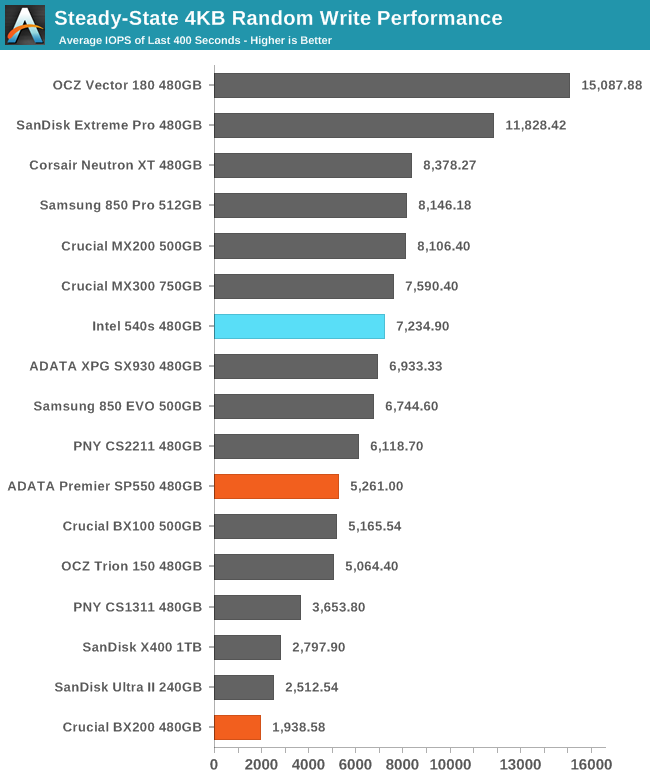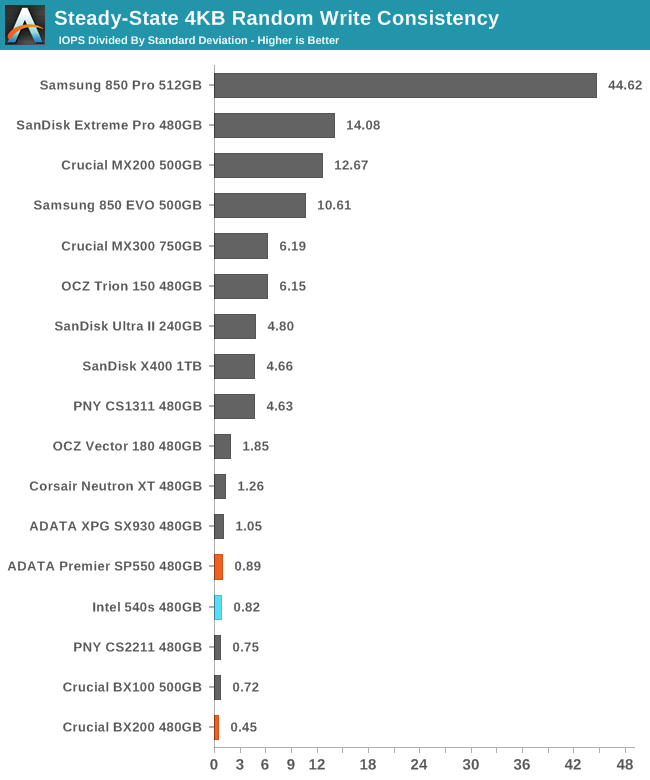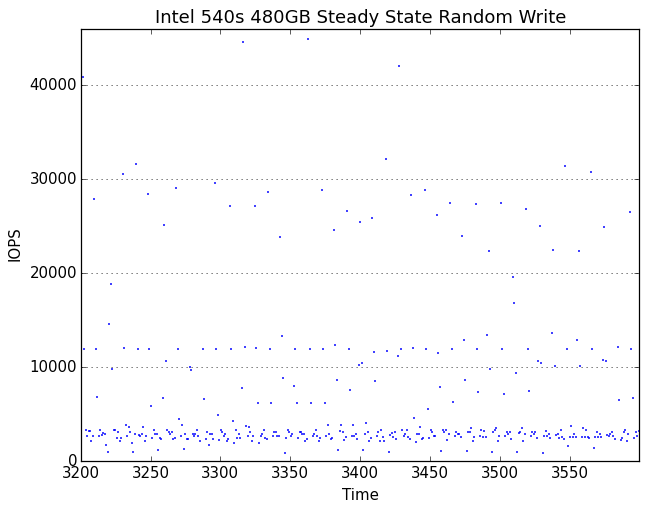The Intel SSD 540s (480GB) Review
by Billy Tallis on June 23, 2016 9:00 AM ESTPerformance Consistency
Our performance consistency test explores the extent to which a drive can reliably sustain performance during a long-duration random write test. Specifications for consumer drives typically list peak performance numbers only attainable in ideal conditions. The performance in a worst-case scenario can be drastically different as over the course of a long test drives can run out of spare area, have to start performing garbage collection, and sometimes even reach power or thermal limits.
In addition to an overall decline in performance, a long test can show patterns in how performance varies on shorter timescales. Some drives will exhibit very little variance in performance from second to second, while others will show massive drops in performance during each garbage collection cycle but otherwise maintain good performance, and others show constantly wide variance. If a drive periodically slows to hard drive levels of performance, it may feel slow to use even if its overall average performance is very high.
To maximally stress the drive's controller and force it to perform garbage collection and wear leveling, this test conducts 4kB random writes with a queue depth of 32. The drive is filled before the start of the test, and the test duration is one hour. Any spare area will be exhausted early in the test and by the end of the hour even the largest drives with the most overprovisioning will have reached a steady state. We use the last 400 seconds of the test to score the drive both on steady-state average writes per second and on its performance divided by the standard deviation.

Right from the start we see a substantial improvement of the SM2258 over SM2256, as steady-state random write speed has increased by 37%. This puts the Intel 540s well ahead of any other planar TLC drive and ahead of a few low-end MLC drives as well.

While the average random write speed has improved, the consistency is a bit worse and the Intel 540s scores in the bottom tier of drives. Phison's most recent generation of TLC drives managed to deliver very consistent steady state performance, but Silicon Motion still has a lot of room for improvement here.
 |
|||||||||
| Default | |||||||||
| 25% Over-Provisioning | |||||||||
The consistency of the 540s was clearly poor even before the transition to steady state, but during that early phase of the test it delivered twice the IOPS of the ADATA SP550.
 |
|||||||||
| Default | |||||||||
| 25% Over-Provisioning | |||||||||
Once in steady state, the 540s performance mostly stays slightly above the SP550. Both drives have frequent outliers beyond their band of usual performance, and the outliers are almost all in the direction of better performance. The Intel drive's outliers hit some much higher peaks than the ADATA SP550, suggesting that the new SM2258 controller may have significantly improved performance on bursty workloads.










77 Comments
View All Comments
Flunk - Thursday, June 23, 2016 - link
Looks like it's on Intel's low-end product map for well into 2017 (which is as far as that goes).BurntMyBacon - Friday, June 24, 2016 - link
I thought that Intel's low-end was the 300 series. Apparently not anymore:https://benchlife.info/mansion-brighton-stony-beac...
Please post another link to a roadmap if you find one not plastered with a website logo.
JKJK - Thursday, June 23, 2016 - link
520 and 530 stuck with us for forever, even still when they where performance wise surpassed by other manufacturers. And the price didn't budge either, so I suppose 540 will be with us for a while.However, I'm pretty disappointed with Intel on this one. Samsung 750 evo and even 850 evo is way cheaper here in Norway.
Impulses - Thursday, June 23, 2016 - link
They're at price parity in the US right now, 'course the EVO is much better for the money...Flunk - Thursday, June 23, 2016 - link
That's a lot of money to pay for a low-end drive with a Silicon Motion controller. Performance like a Trion, price like an 850 Evo. Good work Intel.BrokenCrayons - Thursday, June 23, 2016 - link
In their defense, it's not a terrible performer relative to other planar TLC drives with the same controller. However, that doesn't excuse the much higher price MSRP. Were I in the market for a new drive, I wouldn't write off TLC, but I would write off the 540 right away based on the cost over its nearest competitors.Guspaz - Thursday, June 23, 2016 - link
So, it's an Intel SSD that doesn't use an Intel controller, doesn't use Intel flash, and provides terrible performance at a much higher prices than the competition.What were they thinking? I've always been a bit of an Intel SSD fanboy (the five standalone SSDs that I've bought over the years have all been Intel, all the way back to the G1), but they've clearly lost their way, and I don't think the next SSD that I buy would be an Intel.
hojnikb - Thursday, June 23, 2016 - link
They probably want to bank on the clueless users, that have little idea of SSD performance but know Intel as a brand.BurntMyBacon - Friday, June 24, 2016 - link
@Guspaz: "So, it's an Intel SSD that doesn't use an Intel controller, doesn't use Intel flash, and provides terrible performance at a much higher prices than the competition."They did use Sandforce controllers for a while. Though their performance was pretty decent at the time. Firmware made the difference in reliability. Since they are still doing their own firmware and validation, I don't think the use of a third party controller or flash is an insurmountable problem. I do think that the product is not priced or named correctly. This should be a 300 series part with a 300 series price.
Note: The relatively high price may be correlated with the fact that they have to acquire flash on the open market and not everything they get is necessarily meeting their validation requirements.
pwil - Wednesday, July 27, 2016 - link
3 in 3xx series means 3y warranty.